In nature’s vibrant garden, perhaps nothing captures the eye more than the bright combination of orange and yellow. Flowers in these warm hues are not only striking focal points in any garden but also symbols of positive energy and joy.
From radiant sunflowers to delicate tulips, orange and yellow blooms bring a fresh breeze to any space, infusing vitality into every view.
Continue reading the article to discover the dazzling beauty of these 86 species of captivating orange and yellow flowers.
Different Types of Orange and Yellow Flowers
Orange Begonia
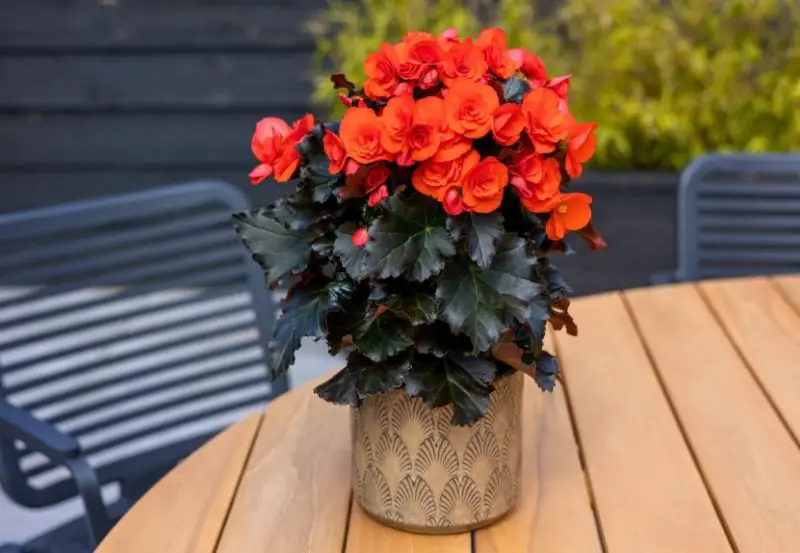
Large, vivid orange blooms of Begonia × tuberhybrida stand out against the plant’s dark green to red leaves. These begonias are perfect for compact spaces because they like high humidity and partial to full shade. They do well in gardens, containers, and hanging baskets; they require well-drained soil and sparing irrigation to maintain uniform soil moisture. Throughout the growing season, fertilize every four to six weeks to maintain attractiveness.
Sunflower
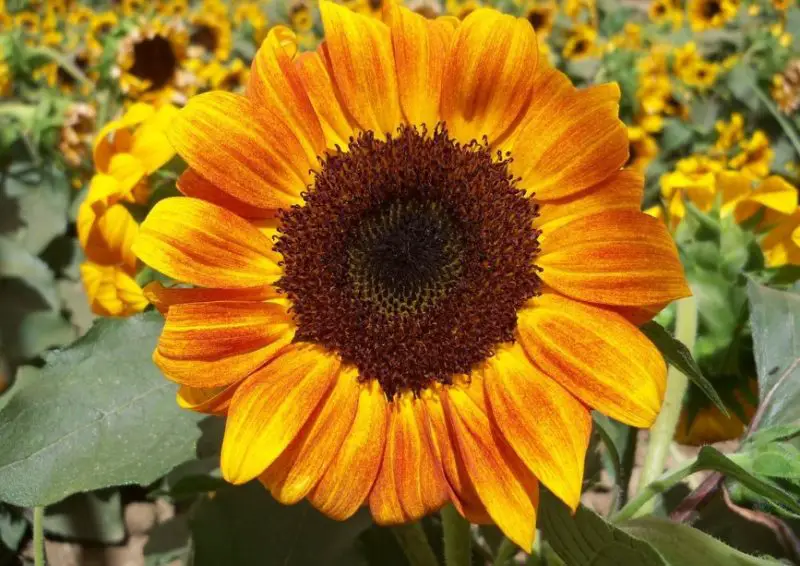
Not only do sunflowers (Helianthus annuus) have cheerful yellow blooms, but they also have vivid orange and crimson types that look great in bouquets. These plants, which are indigenous to the Americas, come in dwarf and towering varieties that reach heights of up to 12 feet. They have undergone careful breeding to produce vibrant colors. They prefer full sun, well-drained soil, and frequent fertilization and watering every four to six weeks.
Carnations
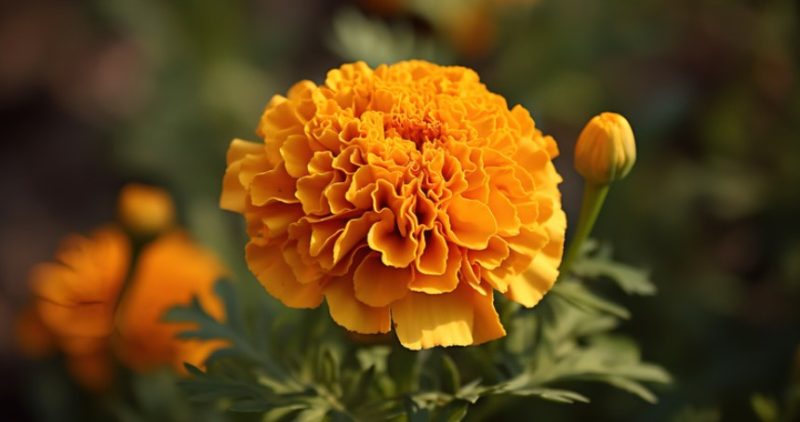
Though deep orange types are sometimes painted, carnations (Dianthus caryophyllus) are prized for their vivid colors, which range from pastel to peach-orange tones. These flowers, whose petals are safe to eat as a salad element or garnish, represent happiness and festivity. Carnations are native to the Mediterranean region and are planted all over the world. They prefer full sun to partial shade, well-drained soil that leans slightly alkaline. During the growing season, fertilize every four to six weeks and give moderate irrigation.
Trumpet Vine
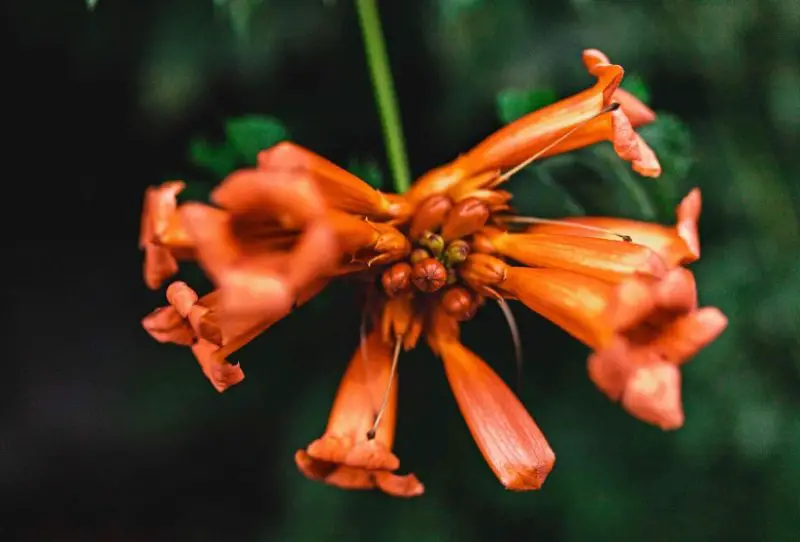
Campsis radicans, commonly known as Trumpet Vine, is a robust and swiftly growing plant that produces eye-catching orange blossoms from summer to fall. It needs full light and well-drained soil to grow, which makes it perfect for covering arbors or fences. It may bloom less frequently in partial shade, but it will still flourish. Originating in the east of the United States, it is also well-liked in Europe and the west. Lush, colorful growth is ensured by consistent fertilization and watering in the middle of summer and early spring.
Orange Poppies

The beautiful Orange Poppies (Papaver orientale) have bright reddish-orange petals. These true orange poppies, as opposed to the California Poppy (Eschscholzia californica), are more tolerant of milder weather and provide fascinating fall seed pods. They thrive in full sun to moderate shade and well-drained, fertile soil, making them ideal for borders and gardens. In the early spring and after flowering, water sparingly and treat with a balanced flower fertilizer.
American Bittersweet
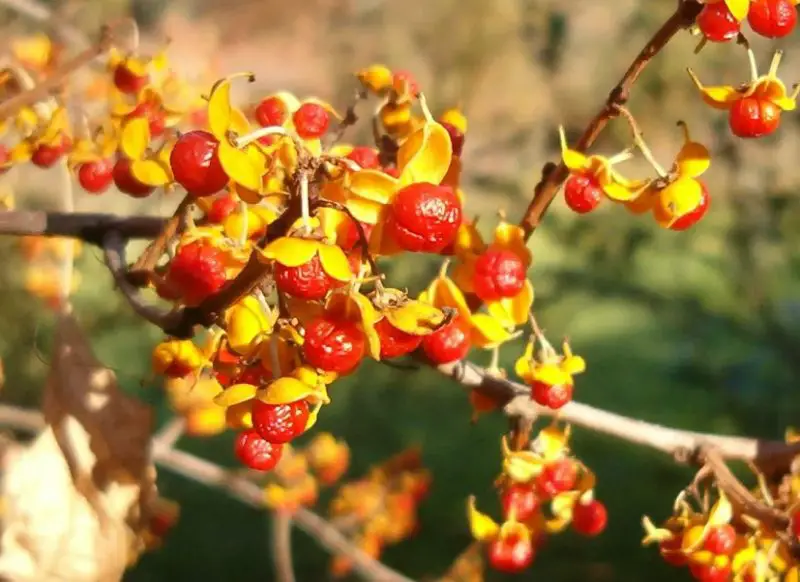
American Bittersweet (Celastrus scandens) is notable for its vibrant orange fruit that persists from fall through winter, rather than its summer flowers. These climbing vines are covered with lush foliage in summer and can quickly cover arbors, fences, or trellises. Though it may be confused with the invasive Oriental bittersweet, the American variety is distinguished by its orange fruit. It thrives in well-drained soil, full sun to partial shade, and benefits from moderate watering and balanced fertilizer in spring and summer.
Indian Mallows
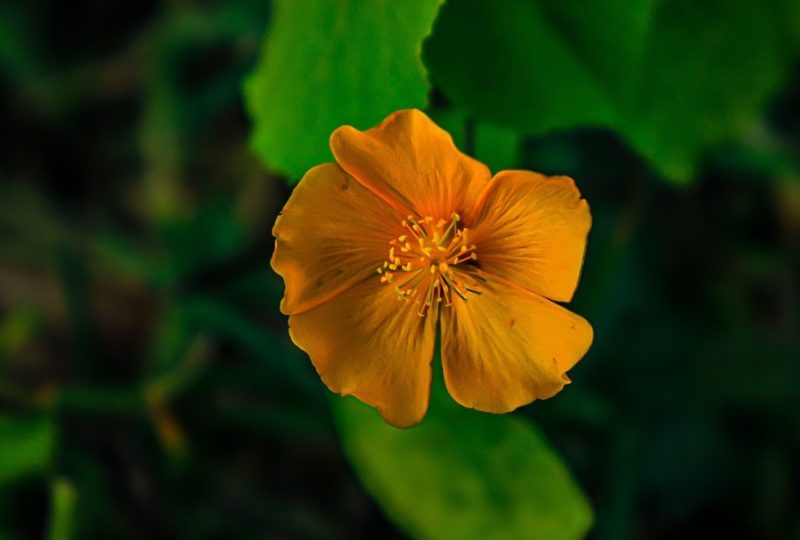
Indian Mallows (Abutilon fruticosum) is a rare member of the Mallow family, native to Mexico and the Southwestern US. Its gold-orange flowers contrast beautifully with pale, sage-colored leaves, and it is a vital food source for local skipper butterflies. Though challenging to cultivate outside its native range, this plant’s cup-shaped flowers and slightly fuzzy leaves make it a striking addition to gardens, borders, or containers. It thrives in well-drained soil, full sun to partial shade, and benefits from moderate watering and balanced fertilizer every 4-6 weeks.
Torch Lily
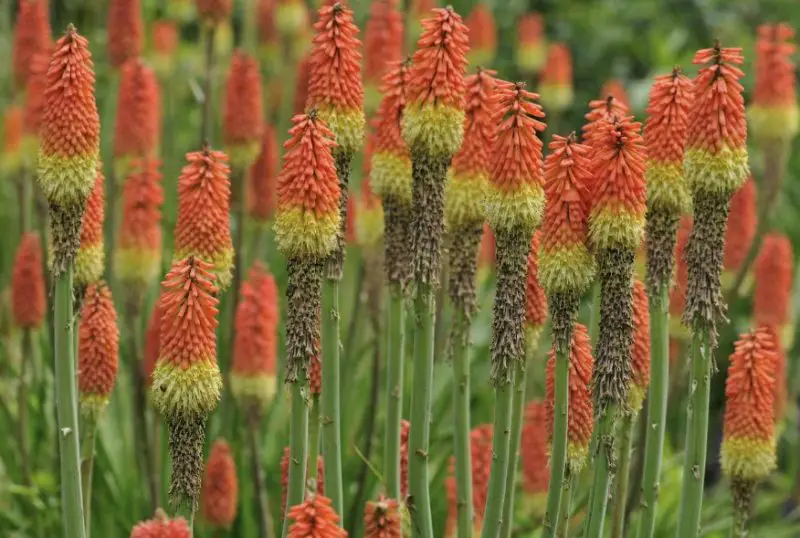
Torch Lily (Kniphofia spp.) features striking flower spikes with dozens of tiny tubular blooms, creating a dramatic appearance. Popular varieties like the Red Hot Poker showcase vibrant red, orange, and yellow hues on the same spike. Native to southern and eastern Africa, these plants are now enjoyed worldwide. They thrive in well-drained, fertile soil with full sun and regular watering. Fertilize with balanced flower fertilizer in early spring and mid-summer for optimal growth.
Lion’s Ear
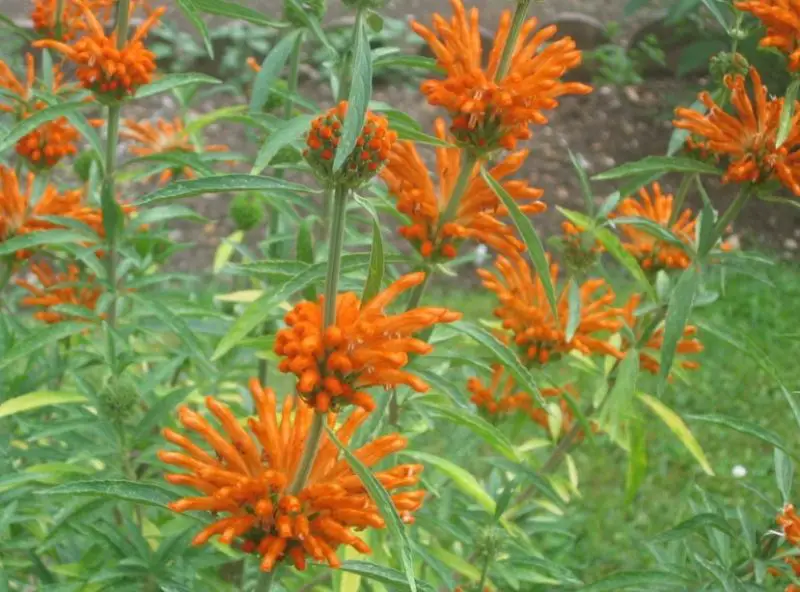
Lion’s Ear (Leonotis leonurus), also known as Lion’s Tail or Dagga, is a striking plant with vibrant orange tubular flowers arranged in circular clusters. Attractive to bees and butterflies, it adds a unique touch to gardens and floral arrangements. Thriving in USDA zones 9–11, it prefers well-drained soil and full sun to partial shade. Once established, it’s drought-tolerant and requires low to moderate watering. Fertilize with a balanced flower fertilizer in early spring and mid-summer.
Daylily
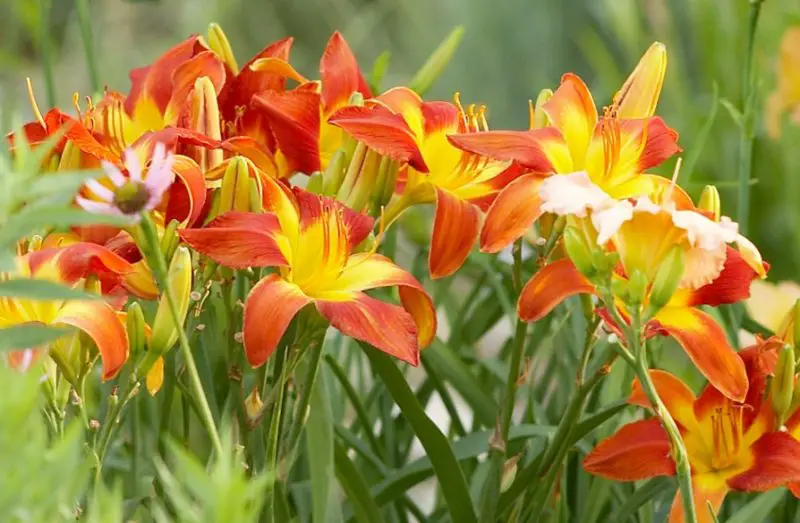
Daylilies (Hemerocallis) are resilient perennials known for their wide range of colors, including striking shades of orange. Despite not being true lilies, they are easier to grow and can thrive in less-than-ideal soil conditions and hot climates where other lilies may struggle. Native to Asia, Daylilies feature thin, grass-like foliage that adds to their appeal. They flourish in full sun to partial shade, requiring moderate watering and balanced fertilizer in early spring and mid-summer.
California poppy
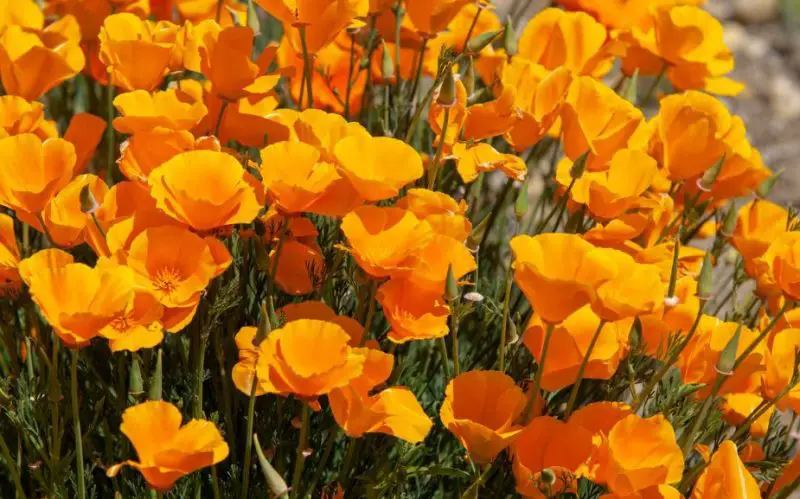
The California poppy, often called the Cup of Gold (Eschscholzia californica), dazzles with its bright orange blossoms and is frequently confused for a real poppie. It grows well in hot, arid areas and is native to California and northwest Mexico. For this reason, it is perfect for gardens and meadows. Once planted, it can withstand drought and thrive in full sun and well-drained sandy soil. In herbal therapy, this plant is also used to cure bedwetting and insomnia.
Pomegranate Tree
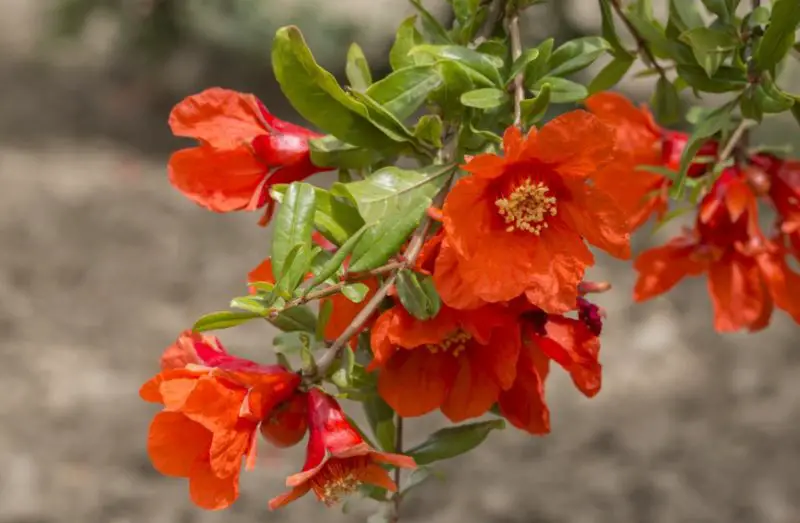
Even in non-fruiting locations, the Pomegranate Tree (Punica granatum) is a valued decorative plant because of its eye-catching orange to red blossoms. Without pruning, it can grow up to thirty feet tall and is evergreen in certain regions. Compared to ordinary kinds, dwarf variants’ blossoms are paler and more orange in color. These trees, which blossom early in warm weather, give gardens bright interest while other plants are still dormant. They grow best in zones 7–11 and require full sun, well-drained soil, and moderate watering.
Orange Zinnia
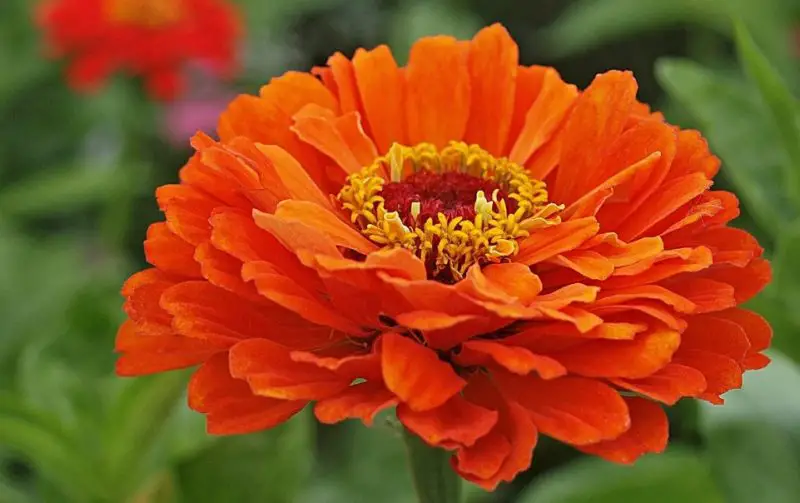
Zinnia elegans, sometimes known as Orange Zinnia, is a simple annual that grows beautifully for bouquets. These vivid flowers thrive in a variety of environments and can reach heights and widths of up to two feet. Originally from the United States and Central America, they are now widely grown throughout Europe and Asia. Orange Zinnias are easily grown from seed or transferred, making them adaptable for gardens, borders, and pots. Their ideal conditions include full sun, well-drained soil, and light irrigation.
Butterfly Bush

Bright orange flower clusters on the Butterfly Bush (Buddleja globosa) draw butterflies and bees. It grows to a height of 15 feet and is native to Argentina and Chile. It does well in USDA zones 7 through 10. This perennial likes frequent watering, full sun to moderate shade, and well-drained soil. It’s a great option for borders and gardens because of its bright blossoms.
Blackberry Lily
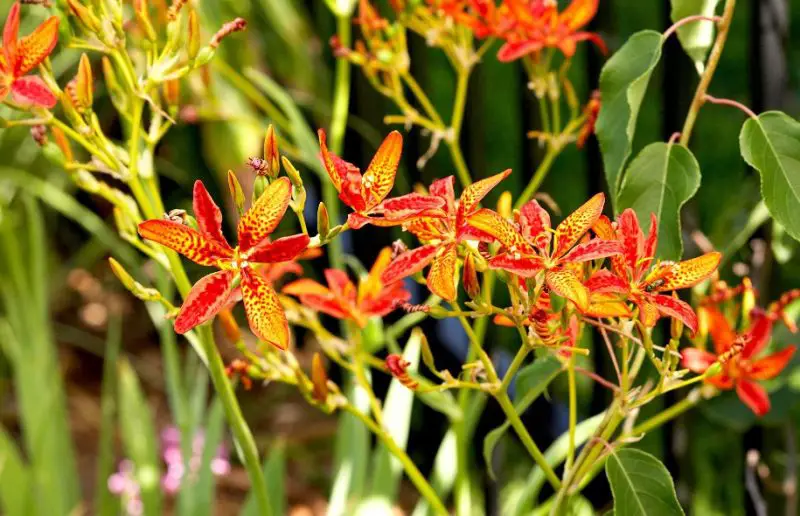
Iris domestica, sometimes known as the Blackberry Lily, has eye-catching orange and scarlet blooms that look great in borders and gardens. It grows best in USDA zones 5 through 10, and it likes full sun over light shade and well-drained soil. This plant likes balanced flower fertilizer in the early spring and midsummer, and it needs moderate watering, letting the soil dry out a little in between treatments. It is a garden favorite due to its brilliant colors and ease of maintenance.
Star of Bethlehem

Bright orange blossoms are exhibited by the Star of Bethlehem (Ornithogalum dubium), which is ideal for gardens, borders, and containers. It grows best on well-drained soil in USDA zones 7 through 10, with full sun to light shade. Once established, this plant can withstand droughts with little watering. Fertilize in early spring and midsummer with a balanced flower fertilizer for the best results.
Coreopsis
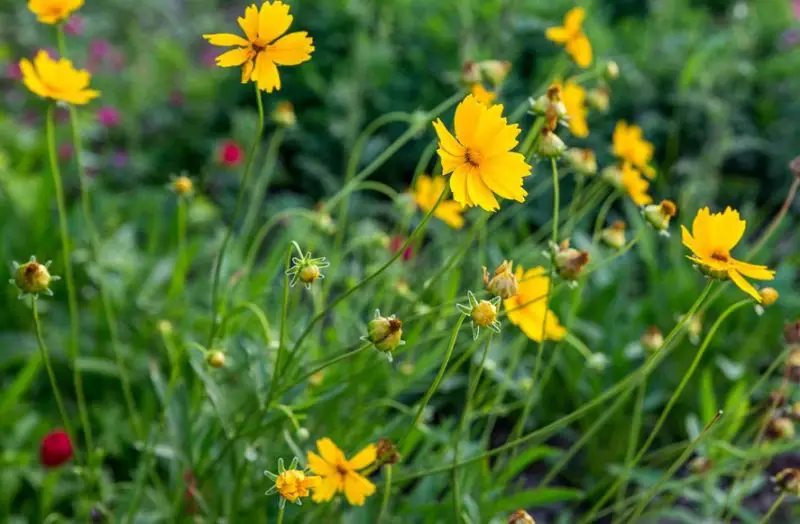
Bright yellow and orange blossoms make Coreopsis (Coreopsis spp.) a great choice for borders, gardens, and pots. It grows best in USDA zones 4 through 9, and it likes full sun, sandy soil that drains well. Once established, this drought-tolerant plant needs low to moderate watering. Fertilize in early spring and midsummer with a balanced flower fertilizer for the best results. Gardeners love it for its vibrant colors and ease of care.
Amaryllis
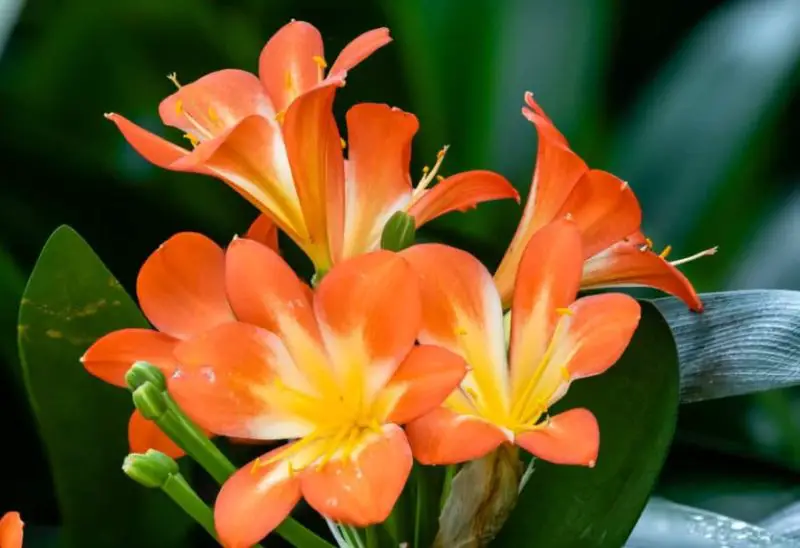
The amaryllis plant (Hippeastrum) is colorful, with vivid orange tones among its many hues. It grows best in USDA zones 9 through 11, yet in colder climates it can be cultivated indoors. This plant prefers full sun to light shade and well-drained soil. It needs to be watered moderately, letting the soil dry out a little in between applications. Apply a balanced floral fertilizer in the spring and summer for optimal effects.
Scarlet Wisteria
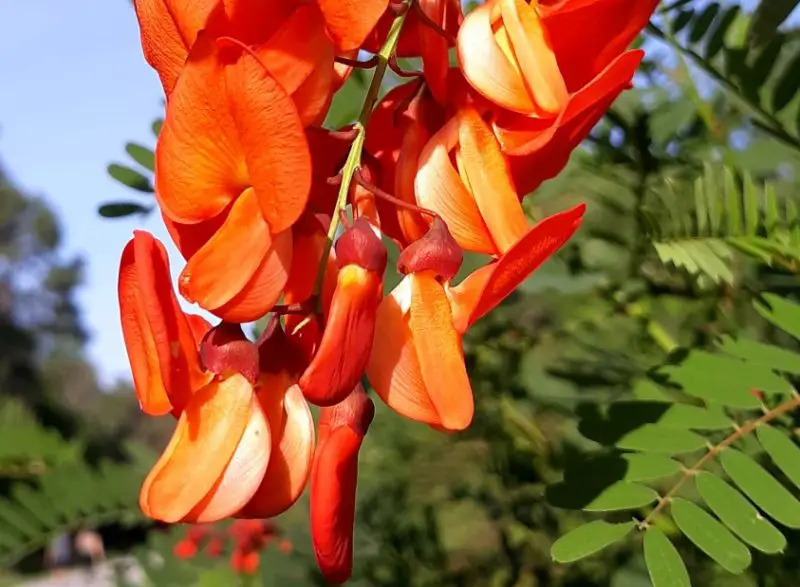
Bright orange and scarlet blossoms make Scarlet Wisteria (Sesbania punicea) an excellent choice for gardens and landscapes. It grows best in USDA zones 8 through 11, and it likes full sun over partial shade and well-drained soil. This plant requires moderate watering, with a little bit of soil drying out in between applications. Fertilize in early spring and midsummer with a balanced flower fertilizer for the best results. Its eye-catching blooms bring vivid color to any scene.
Montbretia
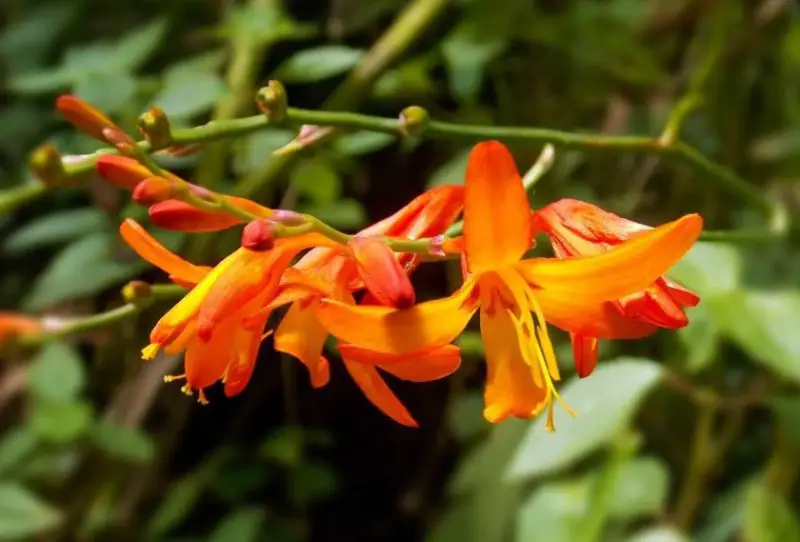
Bright orange, crimson, and yellow blossoms make Montbretia (Crocosmia spp.) a great choice for borders and gardens. It thrives in USDA zones 6 through 9, preferring full sun to partial shade and well-drained soil. To maintain uniform moisture in the soil, this plant needs only modest irrigation. Apply a balanced floral fertilizer in the early spring and midsummer for optimal effects.
Tithonia
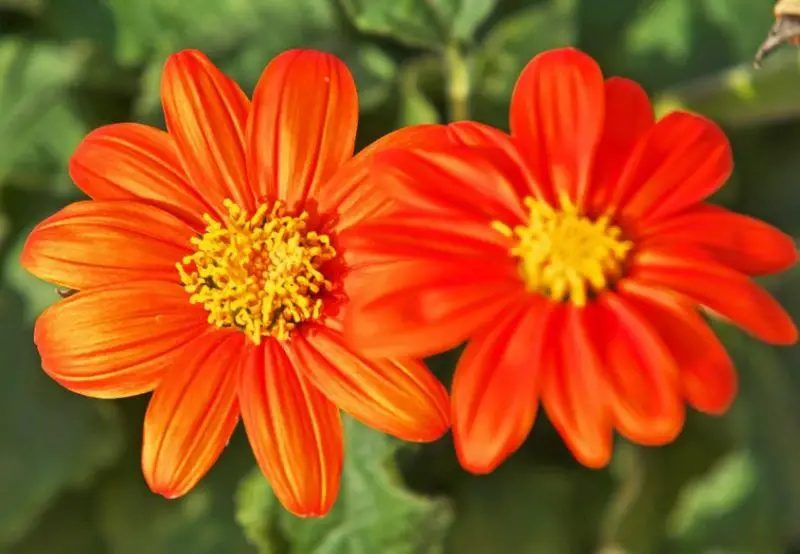
Tithonia (Tithonia rotundifolia) attracts pollinators with its deep reddish-orange, daisy-like blossoms and is simple to cultivate from seed. Most places consider them annuals, but in Central America, they are perennials and can grow up to six feet tall. Known as Mexican Sunflowers, they may require staking due to their weak stems. Plant them in full sun, rich soil that drains well, and give them moderate watering. Every 4–6 weeks, fertilize to promote optimal development.
Cinquefoil
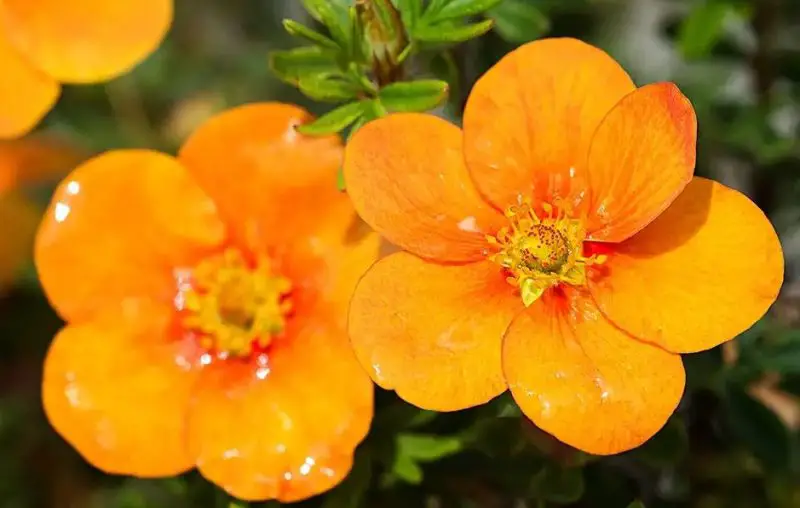
Part of the rose family, cinquefoil (Potentilla spp.) is distinguished by its five-petaled blossoms. This low-growing plant has warm-toned flowers in shades of yellow, white, pink, red, and orange that are sometimes confused for buttercups. Certain types yield tiny, bland-tasting, but edible fruits that taste like strawberries. Cinquefoil grows best in well-drained soil with full sun to partial shade and minimal watering. It is appropriate for rock gardens, borders, and gardens. For optimal effects, fertilize in the early spring and midsummer.
Lantana
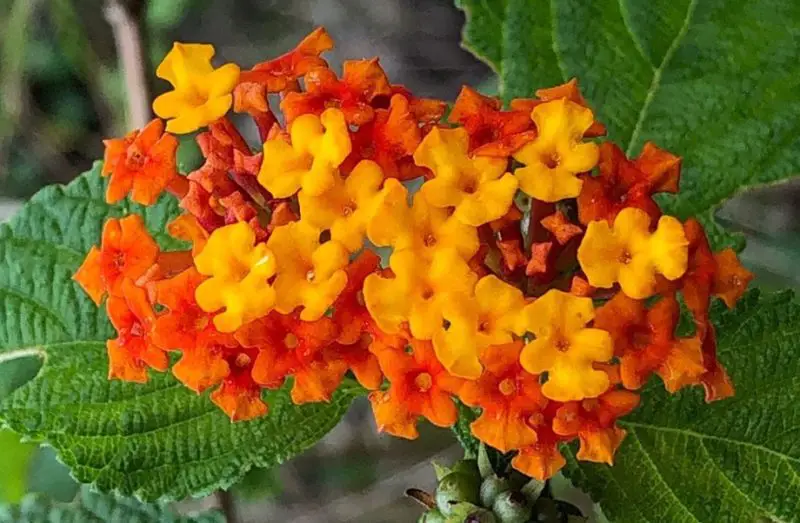
The lively orange and pink blooms of the lantana (Lantana camara) are grouped on stalks that can grow as tall as four feet. Part of the Verbena family, this well-liked landscaping plant is native to tropical Africa and the Americas. All components of the lantana plant are hazardous, despite their attractiveness. Perfect for full sun and well-drained soil, lantanas grow beautifully in gardens, pots, and hanging baskets. During the growing season, fertilize every four to six weeks and give moderate irrigation.
Hibiscus
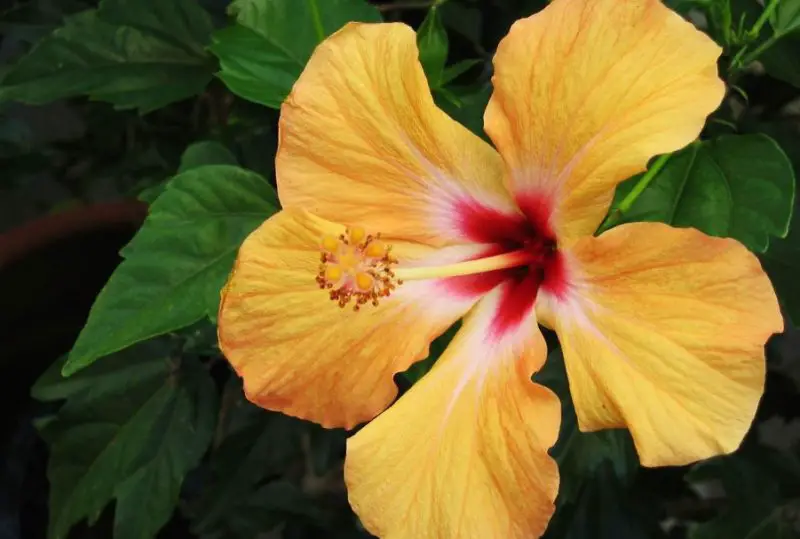
Tropical beauty is exhibited by hibiscus (Hibiscus spp.) with its vivid orange flowers (like Rose Mallow) and verdant foliage. These adaptable plants grow well in gardens and pots, preferring rich, well-drained soil. Hibiscus grows best in growing zones 5 through 11, preferring regular watering and full sun over partial shade. You can even make tea out of some types. For colorful blooms, fertilize every four to six weeks while the plant is growing.
Rhododendron
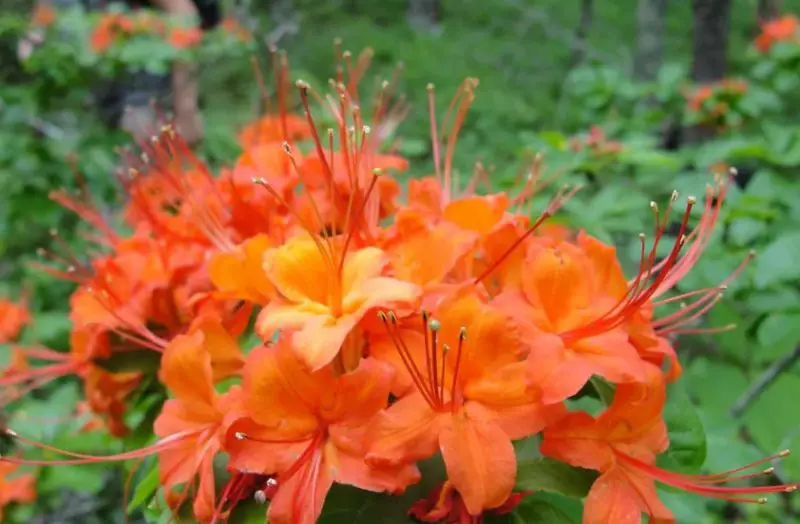
The vivid blossoms of rhododendrons (Rhododendron spp.) range from creamy to vivid orange. These adaptable plants, which are native to Asia, North America, Europe, and Australia, can be formed like trees or shrubs and offer year-round fascination with their evergreen foliage and spring-to-summer beauty. Perfect for gardens and wooded places, they grow best in acidic, well-drained soil that receives partial to full shade. For optimal effects, fertilize in late summer and early spring and water often.
Cockscomb
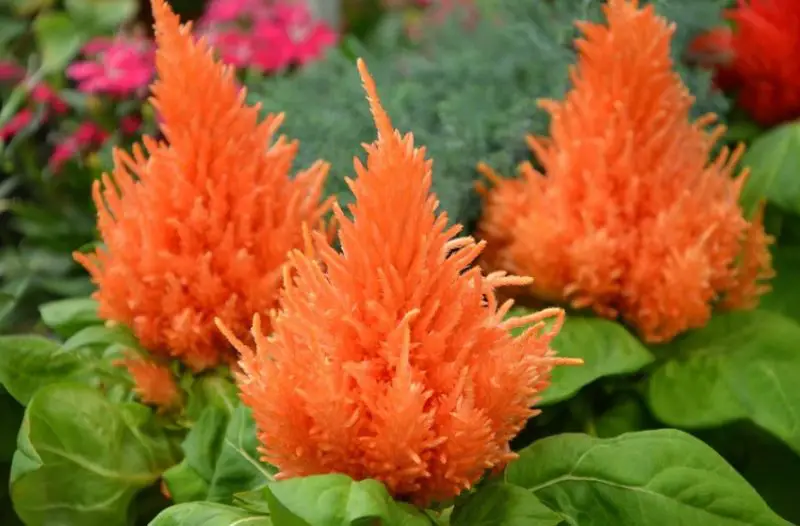
The fiery orange blossoms of cockscomb (Celosia spp.) resemble cauliflower and have a velvety texture, making them ideal for bouquets and landscapes. These fragile annuals are native to Africa and are grown in India and Indonesia. They can be raised from seed or transplanted. They grow best in gardens, borders, and containers with full sun and well-drained, nourishing soil. During the growing season, fertilize every 4–6 weeks and provide moderate irrigation.
Flame of the Forest
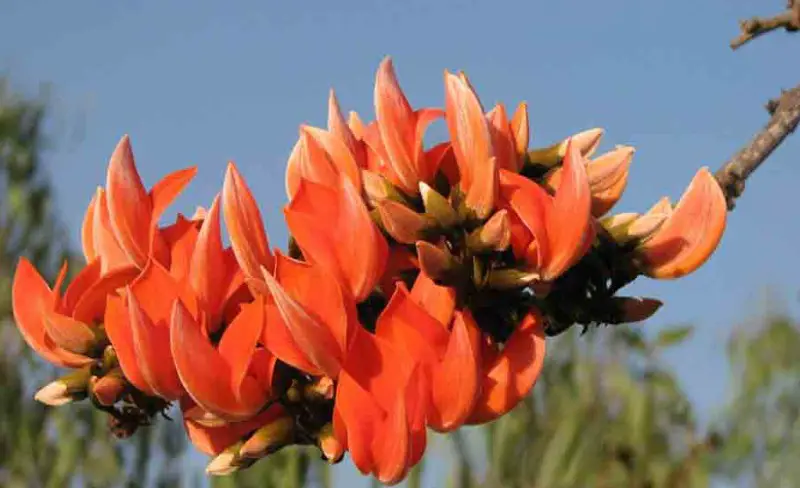
Native to Burma and India, Flame of the Forest (Butea frondosa) is a gorgeous tree named for its vivid flame-orange blooms that blanket the tree in late winter. This plant, which grows to a height of 30 to 40 feet but can be trimmed to a more manageable size, is best suited for warm climates. It is ideal for gardens and landscapes, growing in full sun, well-drained soil, and moderate irrigation. Fertilize in the summer and spring for the best development.
Trumpet Honeysuckle
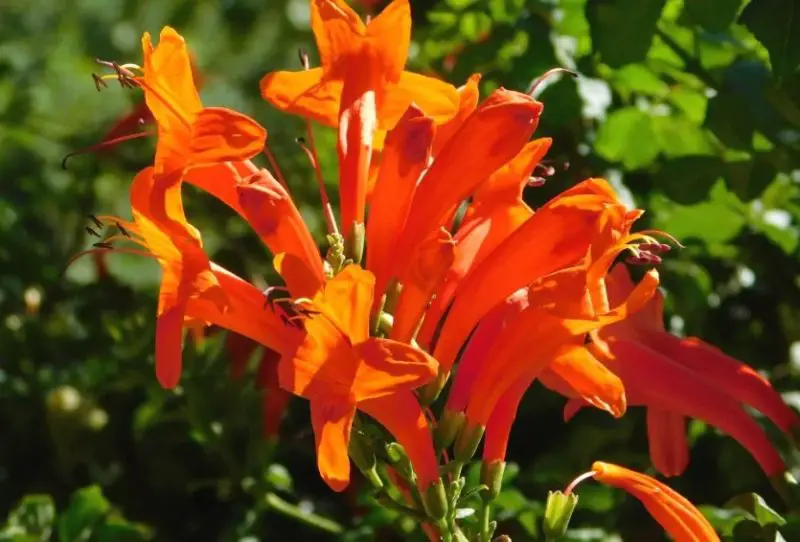
Grow trumpet honeysuckle (Lonicera sempervirens) near the foot of arbors or fences to provide a spectacular summertime display of yellow inside and reddish-orange exteriors. This creeper draws nectar-loving butterflies and hummingbirds to its blossoms. It grows best in well-drained soil, full sun to moderate shade, and is evergreen in warmer climates. In early spring and midsummer, fertilize and water your plants frequently. Every few years, divide and prune to control its spread.
Crown Imperial
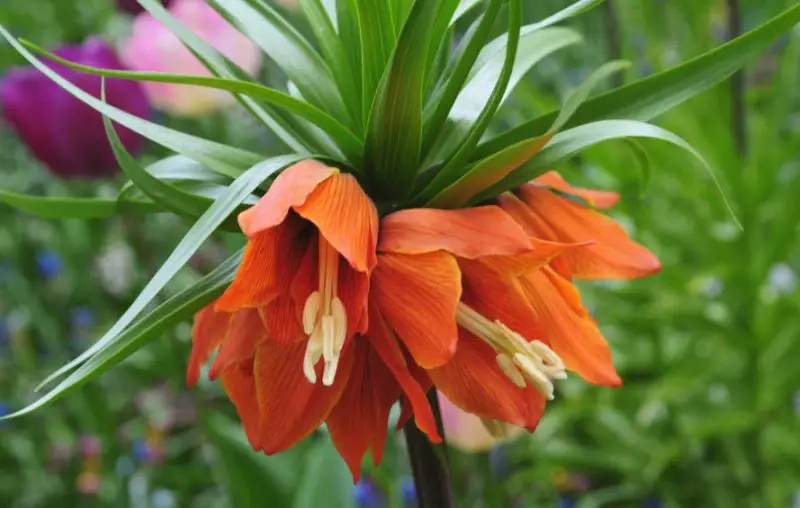
A remarkable variant of the Fritillaria genus, Crown Imperial (Fritillaria imperialis) has orange blooms that face downward and are crowned with green leaves, giving it a distinctive, tropical appearance. This plant, also called the Kaiser’s crown, is hardy to zone 5 and is native to Iran, Iraq, and Turkey. It prefers well-drained soil and full sun to light shade, making it perfect for gardens and borders. After flowering and in the early spring, treat bulbs with a balanced fertilizer and water them moderately.
Butterfly Weed
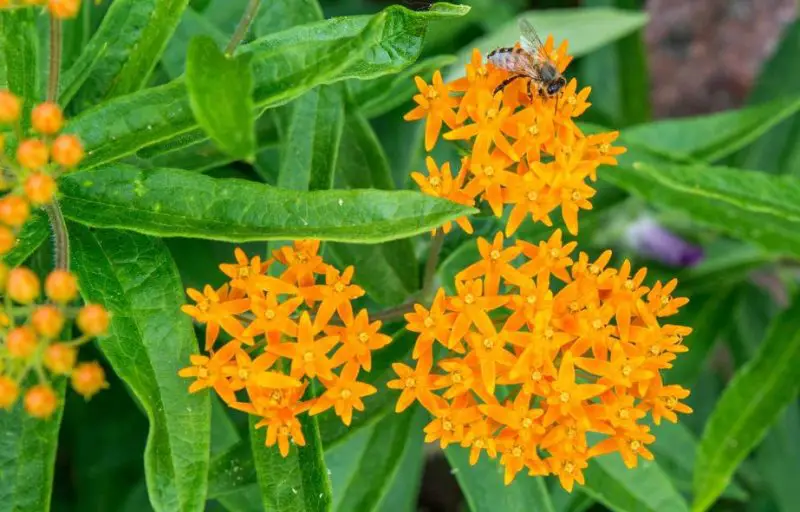
Native to America, Asclepias tuberosa, or butterfly weed, is a milkweed that draws pollinators such as monarch butterflies. It is a beautiful addition to gardens because of its vivid orange tubular flowers that stand out above delicate foliage. This perennial needs full sun, sandy soil that drains well, and it does well in zones 4 through 9. Once planted, it can withstand droughts and needs little to moderate watering. In the early spring, it thrives with balanced flower fertilizer.
Alstroemeria
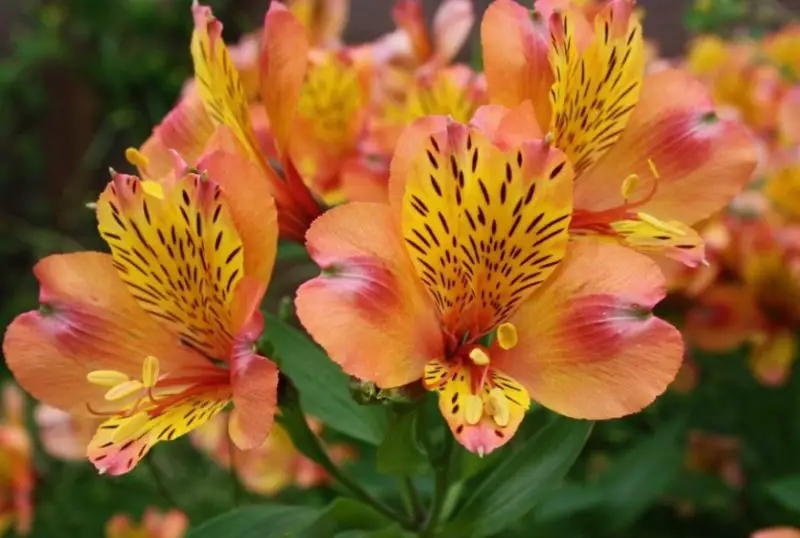
Alstroemeria, or Peruvian lily, grows well in growth zones 7 through 11. These flowers add a pop of color to borders, pots, and gardens with their palette of vivid oranges and gentle pastels. They require four to six hours of direct sunlight every day and like well-drained soil. They may also withstand partial shade or full sun. For best growth, water in moderation, allowing the soil to dry somewhat between applications, and fertilize in the early spring and midsummer with a balanced fertilizer.
Crocus
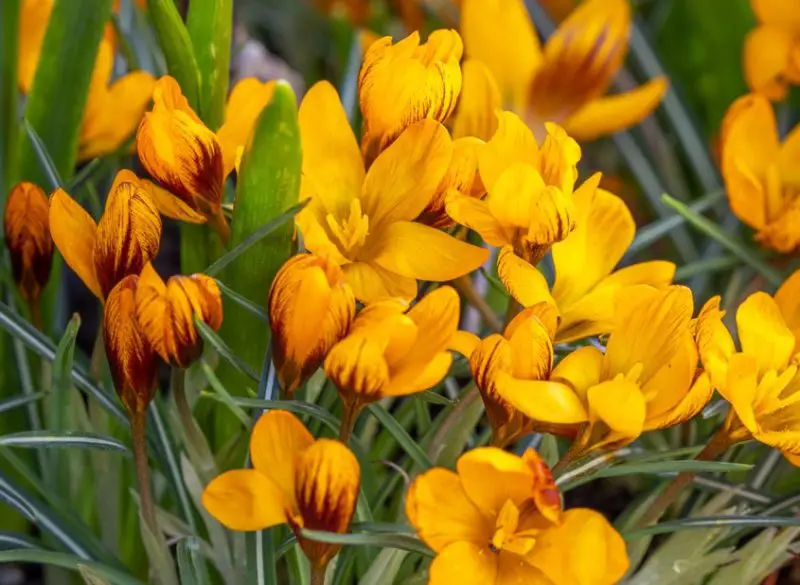
The colorful spring-blooming crocus comes in a wide spectrum of hues, including eye-catching orange tones. It adds color to gardens, borders, and pots and is perfect for growth zones 3–8. Plant in well-drained soil, provide 4-6 hours of direct sunshine per day, and position in full sun to medium shade. Water the soil sparingly, letting it dry out a little bit in between applications. Use bulb fertilizer in the early spring and after blooming for optimal results.
Nemesia

Nemesia thrives in growth zones 9–11, or as an annual in colder climates. It is renowned for its vivid hues and endearing presence, which include shades of orange. It loves well-drained soil and grows best in full sun to moderate shade with 4-6 hours of direct sunlight per day. It is ideal for gardens, borders, and pots. Throughout the growing season, fertilize with a balanced flower fertilizer every two to three weeks, and water the soil lightly to keep it evenly moist.
Cosmos

Cosmos shines with its vivid orange and yellow blossoms, especially Cosmos sulphureus. It grows well in growth zones 2 through 11 and may be grown as an annual in colder areas. It is perfect for borders, meadows, and gardens. Ascertain full sun exposure and plant in well-drained soil. After being established, it can withstand droughts with light to moderate watering. During the growing season, fertilize every 4-6 weeks using a balanced flower fertilizer for best results.
Penstemon
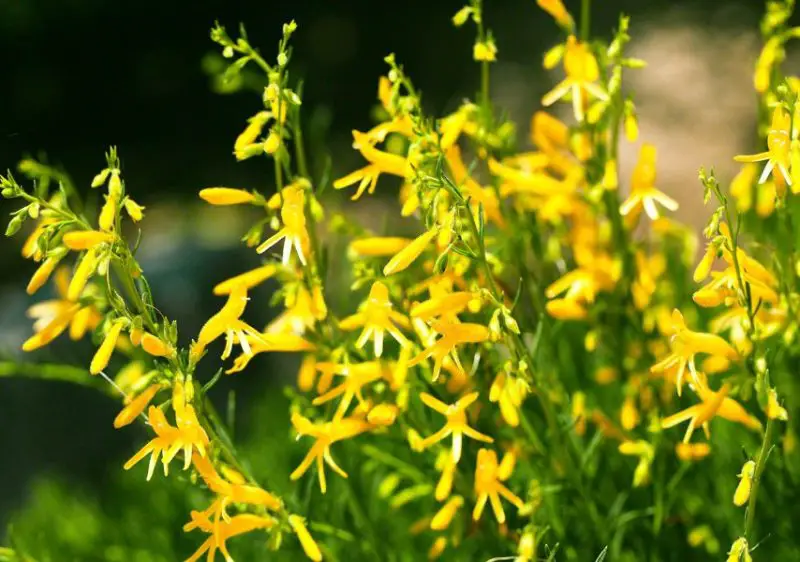
Penstemon enchants with its lovely white, pink, and orange blossoms. Penstemon digitalis in particular. It thrives in gardens, borders, and rock gardens and is suitable for growth zones 3 through 9. Plant in well-drained soil, enjoy 4-6 hours of direct sunlight every day, and place in full sun to medium shade. Once established, it becomes drought-tolerant, so water it lightly to moderately. Apply a balanced floral fertilizer in the early spring and midsummer for optimal effects.
Orange Champaca Tree
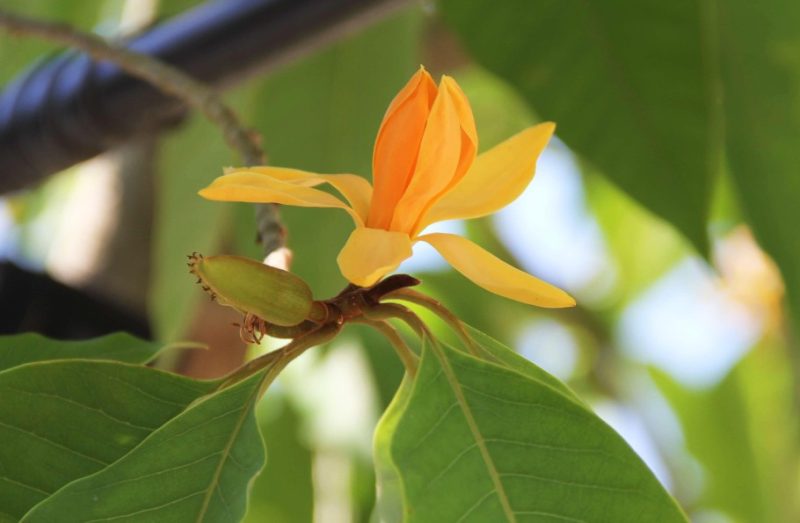
Because of its vivid orange and yellow flowers, the Orange Champaca Tree (Michelia champaca) is well known. It is a beautiful addition to gardens and landscapes, growing well in growth zones 10–12. It grows best in well-drained, fertile soil and can be planted in either full sun or partial shade, with 4-6 hours of direct sunlight per day. For optimum development, apply slow-release fertilizer in the early spring and midsummer and water the soil gently, making sure it is evenly moistened.
Roses
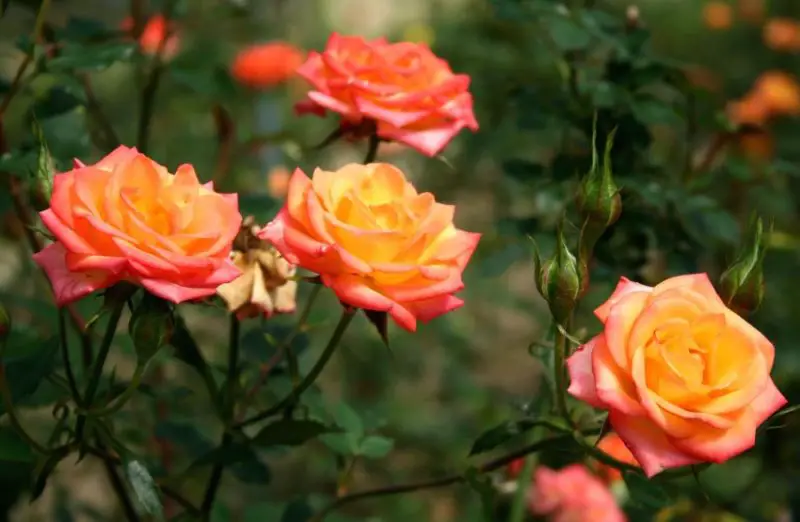
Roses (Rosa spp.) are captivating due to their wide spectrum of hues, which includes gorgeous orange tones. Their growth zones vary by species and cultivar, making them perfect for gardens, landscapes, and containers. Plant them in rich, well-drained soil, and give them six to eight hours of direct sunlight each day. For best blooms and health, use a fertilizer made specifically for roses, and water the soil gently to keep it equally moist. Follow the directions on the fertilizer’s packaging.
Marigolds
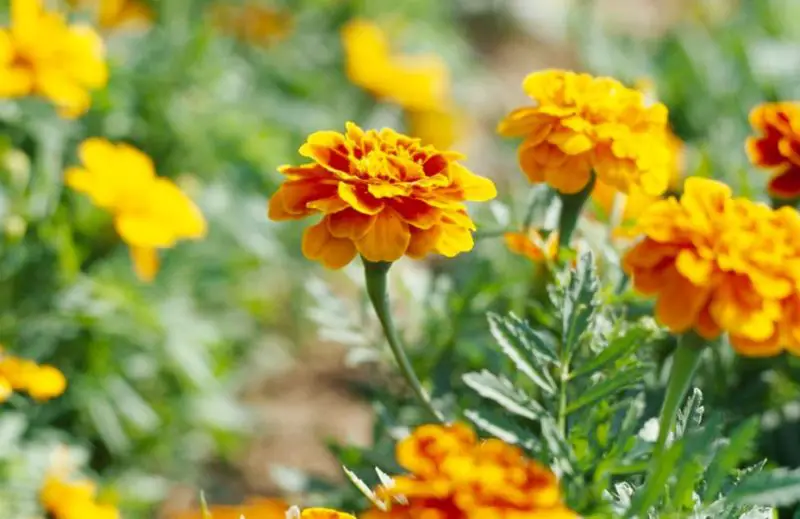
Marigolds (Tagetes erecta) grow well in growth zones 2 through 11 and have brilliant orange and yellow blooms (or as an annual in colder areas). They like full sun and well-drained soil, making them perfect for gardens, borders, and pots. Once planted, they can withstand droughts with light to moderate watering. During the growing season, fertilize every 4-6 weeks using a balanced flower fertilizer for best results.
Ranunculus
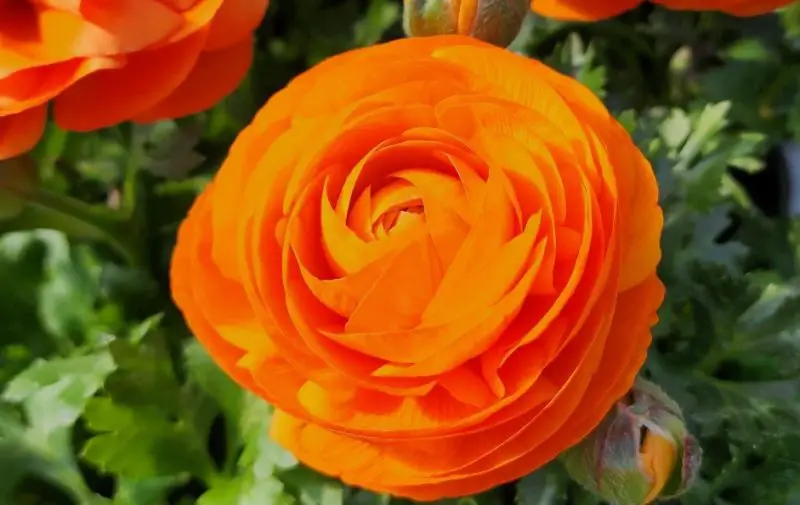
Vibrant orange hues are among the many colors that dazzle in the Ranunculus genus. Its corms can be grown as annuals in cooler climates and are suitable for growth zones 8 through 11. Plant in well-drained soil in borders, gardens, or pots, and give them four to six hours a day of direct sunlight. During the growing season, fertilize with a balanced flower fertilizer every 4-6 weeks, and water the soil lightly to keep it equally moist.
Iris
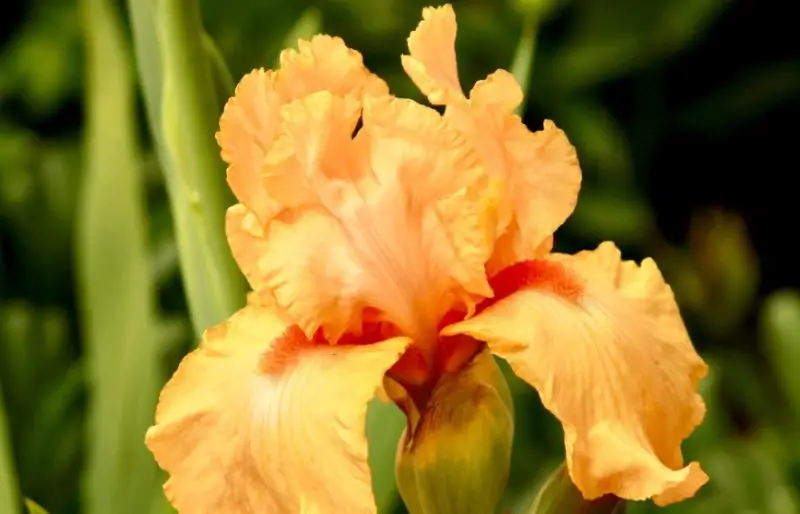
Vibrant tints of orange are among the amazing diversity of colors that the iris (Iris spp.) displays. It grows well in gardens, borders, and water gardens and is suitable for a variety of growth zones, depending on the species and cultivar selected. Plant them in soil that drains well, and give them full sun to partial shade so they receive four to six hours of direct sunlight per day. For best growth, apply a balanced floral fertilizer in the early spring and midsummer, and water the soil lightly to maintain an even moisture level.
Orange Tulips
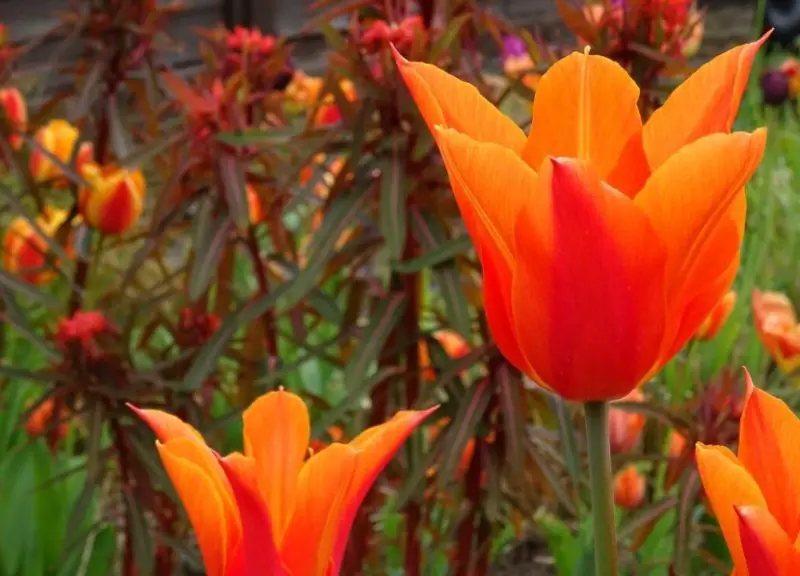
Bright orange hues are among the many colors that tulips (Tulipa spp.) mesmerize with. They are great for borders, gardens, and containers and grow well in growing zones 3–8. Plant on soil that drains well, and make sure they get four to six hours a day in direct sunlight, from full to moderate shade. For optimal results, fertilize with a bulb fertilizer in early spring and after blooming, and water sparingly, letting the soil dry somewhat between applications.
Orange Pansies
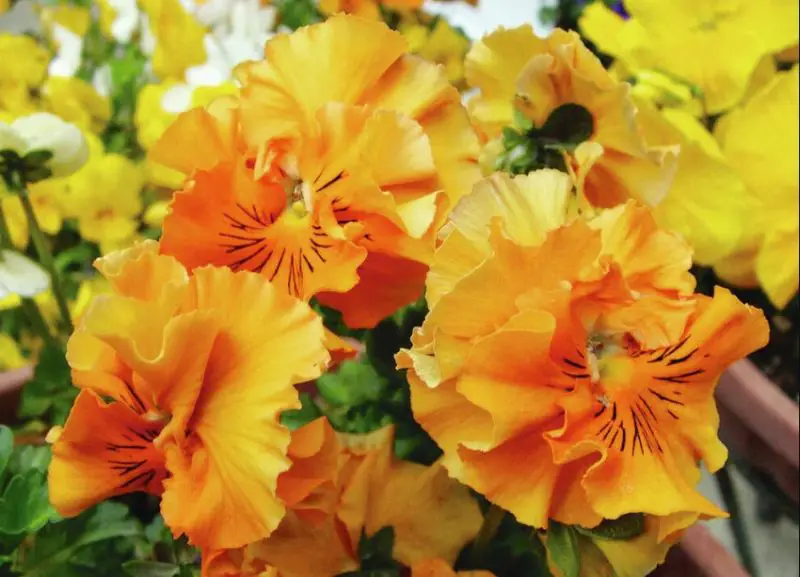
Vibrant orange hues are among the cheery splashes of color that pansies (Viola tricolor var. hortensis) add to gardens, borders, and containers. As a cool-season annual, they thrive in growth zones 4–8 and appreciate well-drained soil with full sun to partial shade, receiving 4-6 hours of direct sunlight per day. Throughout the growing season, fertilize with a balanced flower fertilizer every two to three weeks to achieve the best possible flowers. Water the soil lightly to keep it evenly moist.
Red Silk Cotton Tree
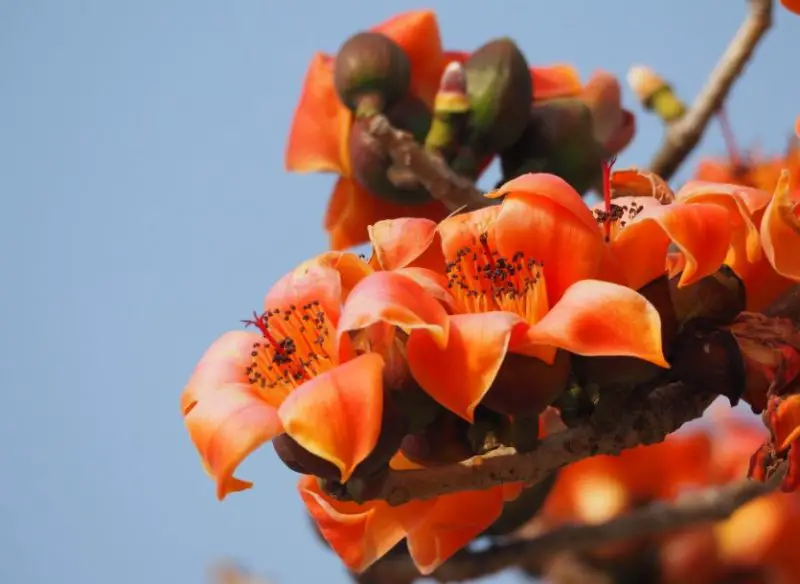
The captivating red and orange blossoms of the Red Silk Cotton Tree (Bombax ceiba) enchant onlookers. It thrives in growth zones 10–11 and is ideal for landscapes and gardens. For best development, plant in well-drained soil and make sure it receives full sun exposure. To promote its beautiful foliage and flowers, water gently, letting the soil dry somewhat between waterings, and fertilize in the early spring and midsummer with a balanced tree fertilizer.
Wallflower
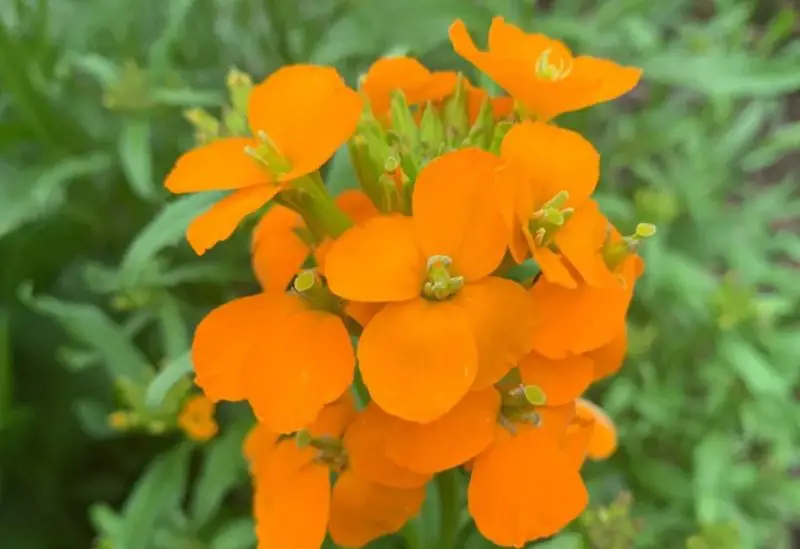
Erysimum capitatum, the wallflower, dazzles with its vivid orange and scarlet blossoms. It grows well in gardens, borders, and rock gardens and is best suited for growing zones 4–9. Plant them in soil that drains well, and give them four to six hours a day in direct sunlight or full sun to partial shade. Once established, it becomes drought-tolerant, so water it lightly to moderately. During the growing season, fertilize every 4-6 weeks using a balanced flower fertilizer for best results.
Angel’s Trumpet
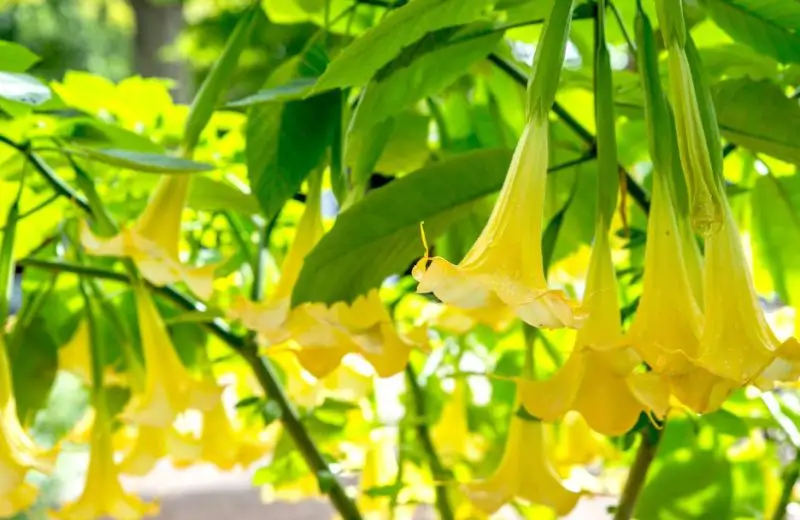
Bergmansia versicolor, often known as Angel’s Trumpet, mesmerizes with its vivid orange and yellow blossoms. Growing in zones 9 through 11, this plant thrives in gardens and landscapes and can be brought indoors in colder areas in containers. Plant in well-drained soil, enjoy four to six hours of direct sunshine per day, and give them full sun to partial shade. Throughout the growing season, fertilize with a balanced flower fertilizer every two to three weeks, and water the soil lightly to keep it evenly moist.
Orange Nasturtium
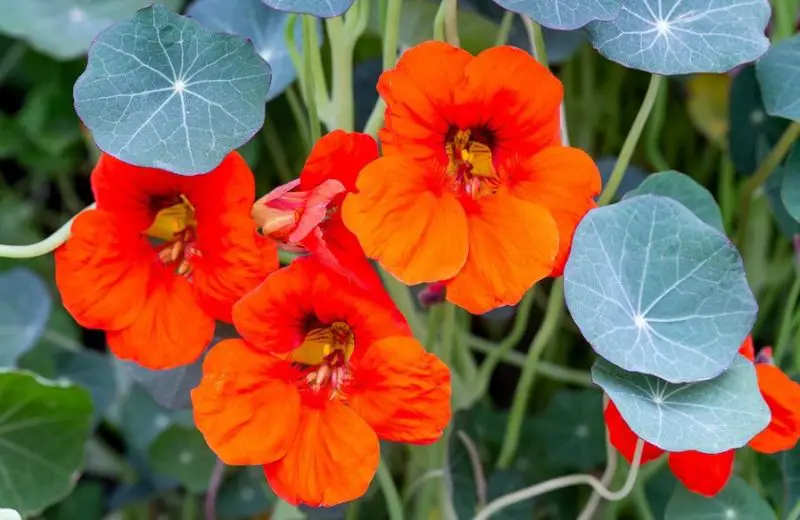
Tropaeolum majus, or nasturtium, adds color with its vivid orange and yellow blossoms. It grows well in gardens, borders, and containers and may be grown in growth zones 2 through 11. In colder locations, it can be grown as an annual. Plant them in soil that drains well, and give them four to six hours a day in direct sunlight or full sun to partial shade. Once established, it can withstand droughts with mild to moderate watering. During the growing season, fertilize every four to six weeks using a balanced flower fertilizer.
Cymbidium Orchid
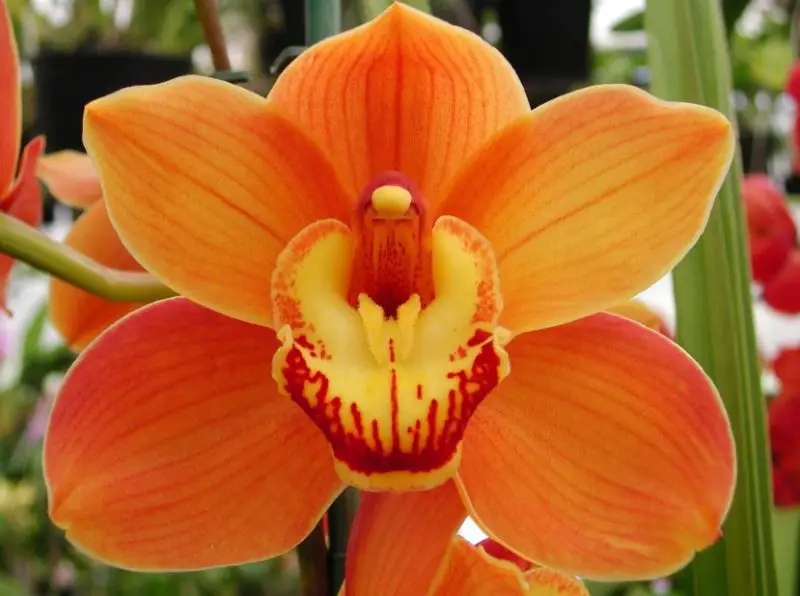
Cymbidium orchids (Cymbidium spp.) enthrall with their vivid color spectrum, which includes eye-catching orange tones. It can be cultivated indoors in pots or outdoors in gardens in climates that are good for it, depending on the species and cultivar. Make use of an orchid mix that drains effectively and give it bright, indirect light. Water sparingly, letting the growing medium air dry a little in between applications, then fertilize using an orchid-specific fertilizer per the directions on the container.
Red Hot Pokers
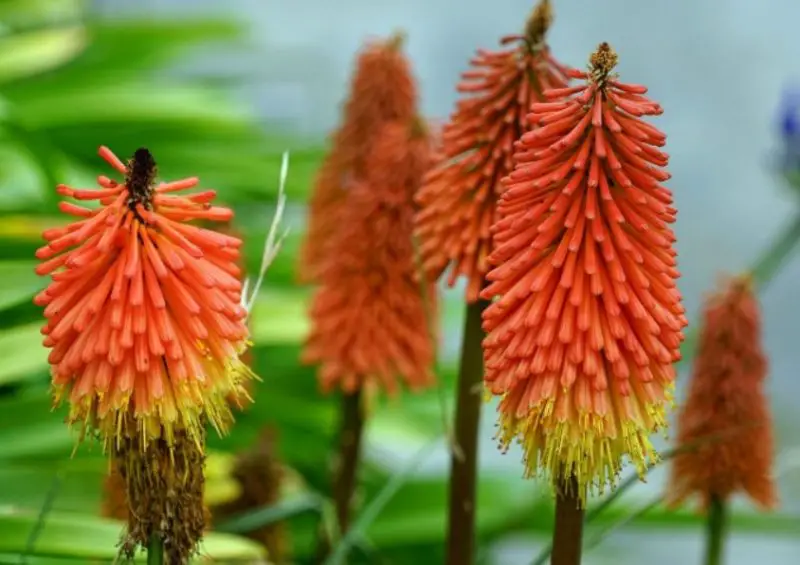
Kniphofia uvaria, or red hot pokers, gleam brightly in orange, red, and yellow tones. They thrive in growing zones 5 through 9, making them ideal for borders and gardens. Plant them in soil that drains well, and give them four to six hours a day in direct sunlight or full sun to partial shade. Once planted, they can withstand droughts with light to moderate watering. During the growing season, fertilize every 4-6 weeks using a balanced flower fertilizer for optimal results.
Chrysanthemum
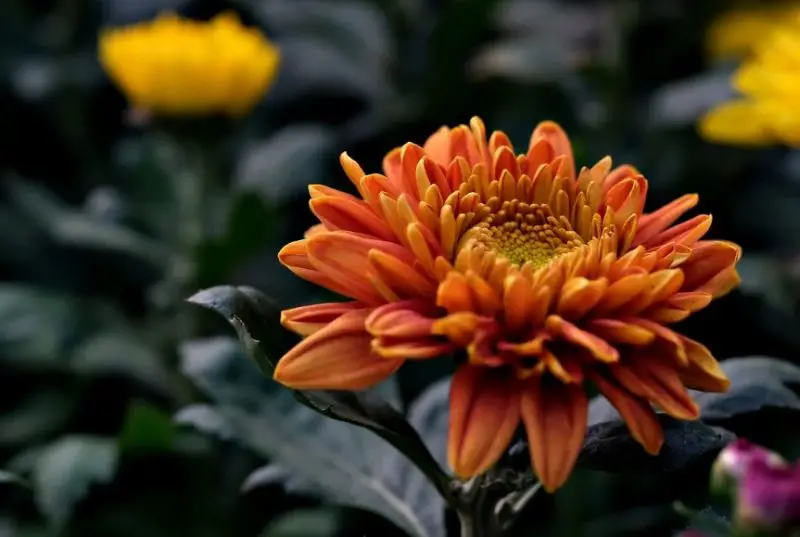
The colorful spectrum of chrysanthemums (Chrysanthemum spp.) includes warm tones of orange. They grow well in borders, gardens, and pots and are suitable for a variety of growth zones based on the species and cultivar. Plant them in soil that drains well, and give them four to six hours a day in direct sunlight, or full sun to partial shade. During the growing season, fertilize with a balanced flower fertilizer every two to three weeks and water the soil sparingly, letting it dry out a little between applications.
Apricot Sprite Hyssop
![]()
Apricot Sprite Hyssop (Agastache aurantiaca ‘Apricot Sprite’) enchants with its apricot and orange blooms. Ideal for growing zones 6–10, it thrives in gardens and borders. Plant in well-drained soil and provide full sun for optimal growth. Water lightly to moderately, as it becomes drought-tolerant once established. For best results, fertilize with a balanced flower fertilizer every 4-6 weeks during the growing season.
Strawflower
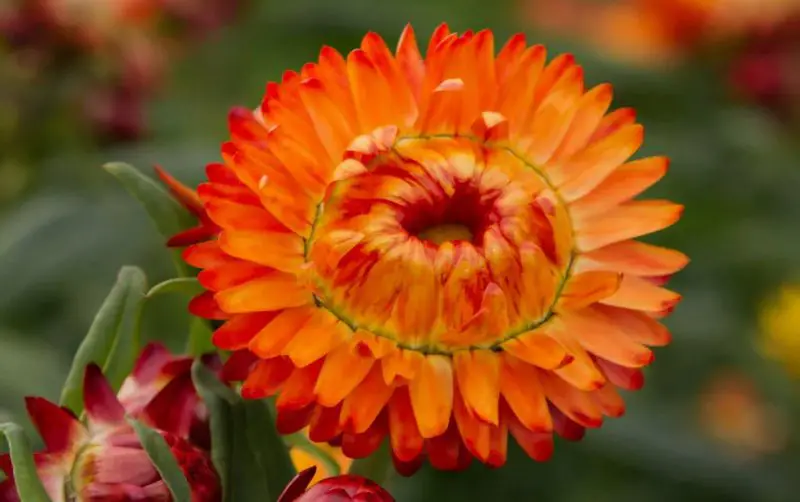
Xerochrysum bracteatum, or strawflower, grows well in zones 8 through 11, with bright orange and yellow blossoms. It likes full sun and well-drained soil, making it perfect for borders and gardens. Once planted, it needs little watering and can withstand drought. During the growing season, fertilize every 4-6 weeks using a balanced flower fertilizer for optimal growth.
Frangipani
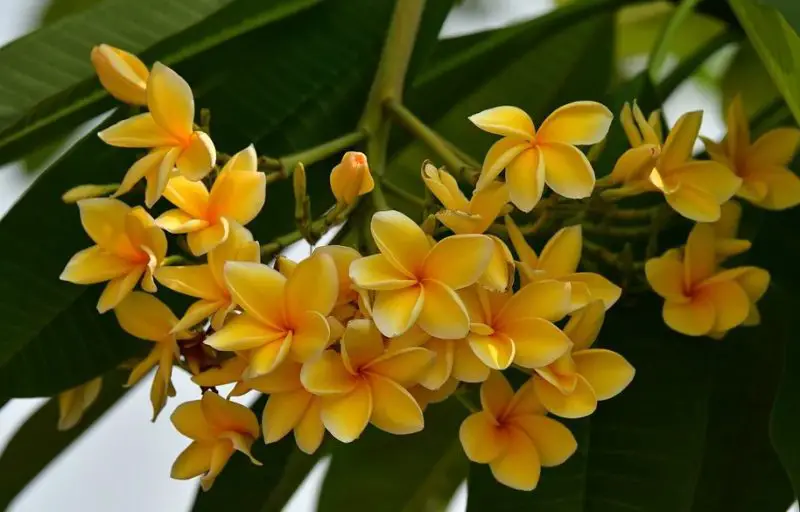
Plumeria spp., or frangipani, thrives in zones 10–12. They have a range of hues, including orange tones. It is best suited for gardens and containers, and it needs full light and well-drained soil. Once planted, it needs little watering and can withstand drought. During the growing season, fertilize every two to three weeks using a balanced flower fertilizer to encourage development.
Orange Anthurium
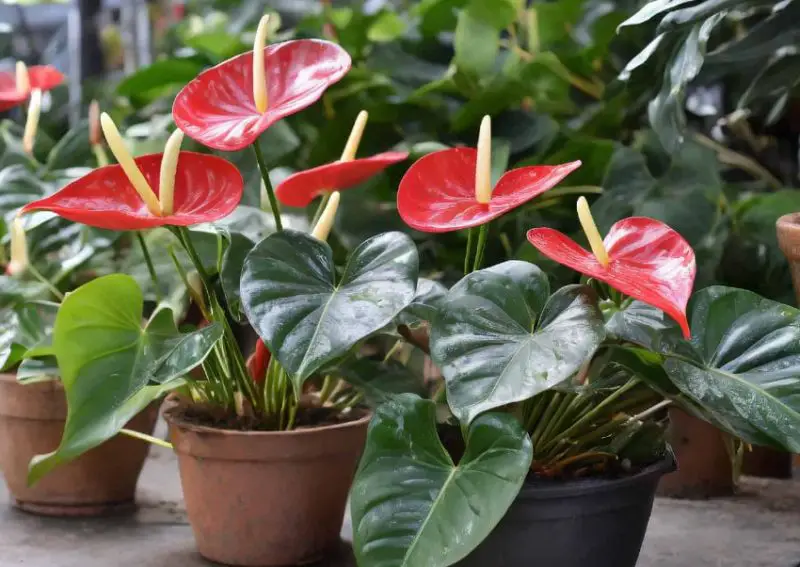
It is possible to raise orange anthurium (Anthurium andreanum) indoors, and it grows well in zones 10–11. It looks great in containers or tropical gardens, with its vivid orange blossoms. It grows best in moderate to full shade with 2-4 hours of direct sunlight per day and prefers well-drained soil. During the growing season, fertilize every two to three weeks with a balanced flower fertilizer and keep the soil equally moist with light irrigation.
Gerbera Daisy
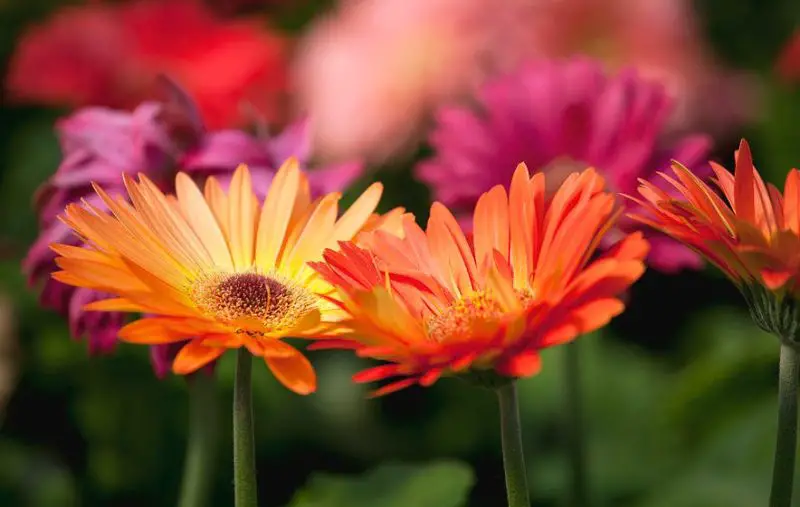
In cooler climates, Gerbera daisies (Gerbera jamesonii) are annuals that grow well in zones 9 through 11. With a spectrum of hues, including orange tones, it’s ideal for pots and gardens. This plant grows best in full sun to moderate shade with four to six hours of direct sunshine every day. It also needs well-drained soil. Throughout the growing season, fertilize with a balanced flower fertilizer every two to three weeks, and maintain moderate watering to keep the soil properly moist.
Orange Bougainvillea

Bougainvillea x buttiana, sometimes known as orange bougainvillea, is a hardy plant that flowers bright orange and pink in zones 9–11. Perfect for gardens and landscapes, it requires a trellis or other support. This plant likes full light and well-drained soil. Once planted, it needs little to no watering and can withstand droughts. During the growing season, fertilize every two to three weeks with a balanced flower fertilizer for the best results.
Dahlia
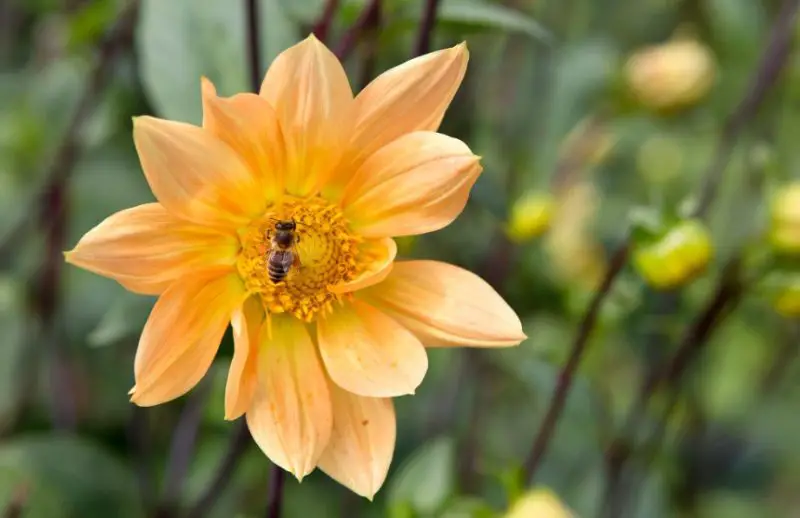
The dahlia, or Dahlia pinnata, is a great plant for borders and gardens. It comes in a variety of colors, including orange. A cultivar’s growth zones differ. This plant prefers full light and well-drained soil. To maintain uniform soil moisture, continue moderate watering. During the growing season, fertilize every two to three weeks with a balanced flower fertilizer for the best results.
Heliconia Rostrata
![]()
Zones 9–11 are ideal for Heliconia Rostrata, which produces vivid orange, red, and yellow blooms. Perfect for large-scale gardens and landscapes, it needs well-drained soil. This plant requires four to six hours a day of direct sunlight to flourish in full sun to partial shade. Water the soil sparingly, letting it dry out a little bit in between applications. Throughout the growing season, fertilize every two to three weeks using a balanced flower fertilizer.
Hawkweed
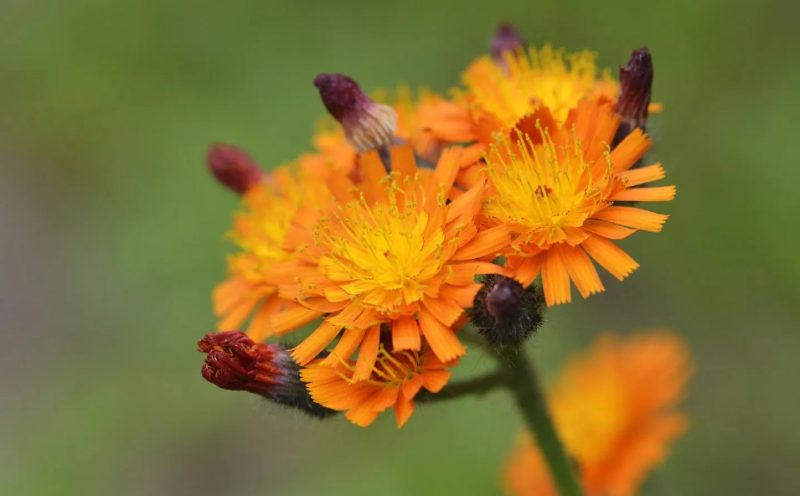
Growing in zones 3 through 9, hawkweed (Hieracium aurantiacum) has bright orange and yellow flowers. Perfect for gardens and meadows, it needs well-drained soil, full sun to partial shade, and four to six hours of direct sunlight every day to thrive. Once planted, it needs little to no watering and can withstand droughts. During the growing season, fertilize every 4-6 weeks using a balanced flower fertilizer for optimal growth.
Crocosmia
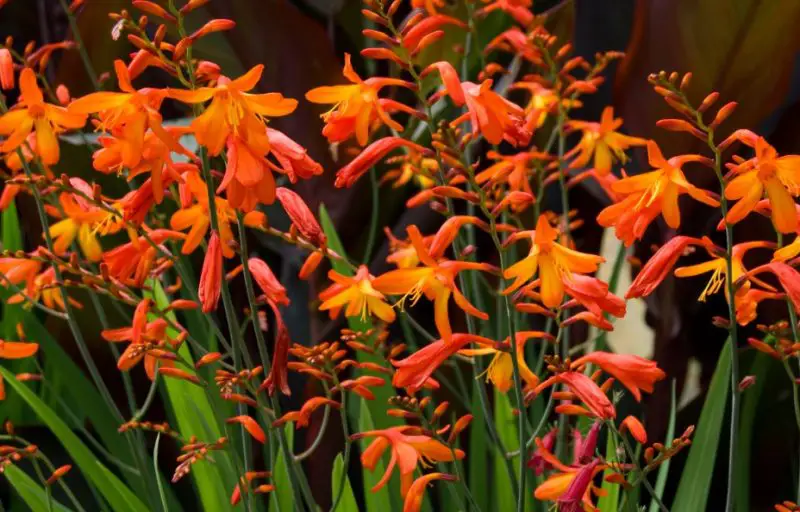
Growing well in zones 6–9, crocosmia (Crocosmia aurea) has vivid orange, red, and yellow blossoms. It is best suited for borders and gardens with well-drained soil, full sun to moderate shade, and four to six hours of direct sunlight per day. Water the soil sparingly, letting it dry out a little bit in between applications. During the growing season, fertilize every two to three weeks with a balanced flower fertilizer for the best results.
Bird of Paradise
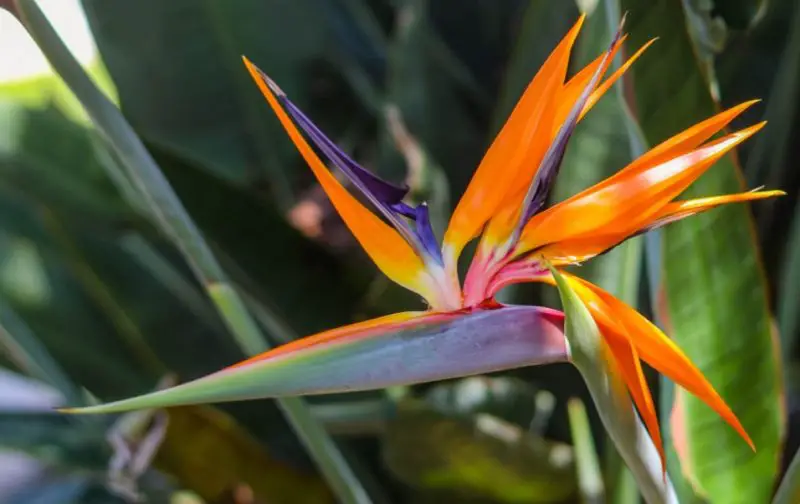
Strelitzia reginae, or bird of paradise, thrives in zones 9 through 11 and has eye-catching orange and blue flowers. Perfect for large-scale gardens and landscapes, it needs well-drained soil, full sun to moderate shade, and four to six hours of direct sunlight every day. Once grown, it requires little watering and can withstand drought. During the growing season, fertilize every two to three weeks with a balanced flower fertilizer for the best results.
Chinese Lantern Plant
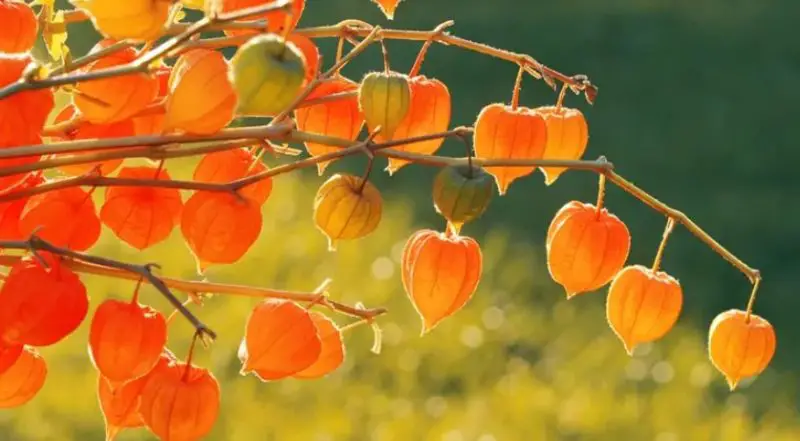
The Chinese Lantern Plant (Physalis alkekengi) bears vivid orange and crimson lantern-like blooms and is hardy in zones 3 through 9. It grows best in well-drained soil and can withstand full sun to partial shade with four to six hours of direct sunlight per day. It is ideal for gardens and borders. To maintain uniform soil moisture, continue moderate watering. During the growing season, fertilize every two to three weeks with a balanced flower fertilizer for optimal results.
Tiger Lily
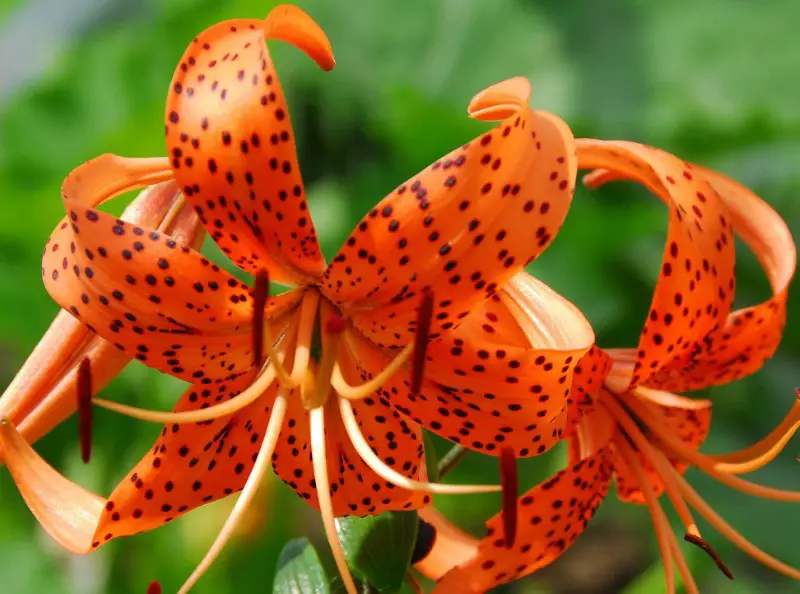
Zones 3–9 are ideal for the Tiger Lily (Lilium lancifolium), which has striking orange and yellow blossoms. It grows best in well-drained soil and can be grown in full sun to moderate shade, receiving four to six hours of direct sunlight each day. It is perfect for borders and gardens. To keep the soil evenly moist, water it sparingly. During the growing season, fertilize every two to three weeks with a balanced flower fertilizer for the best results.






